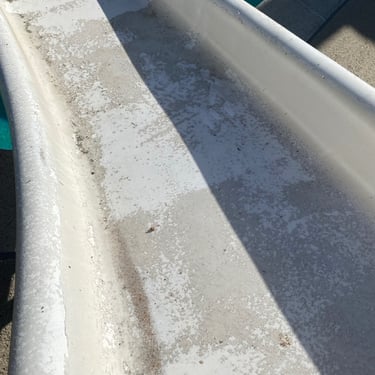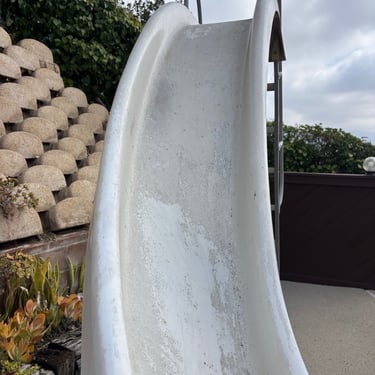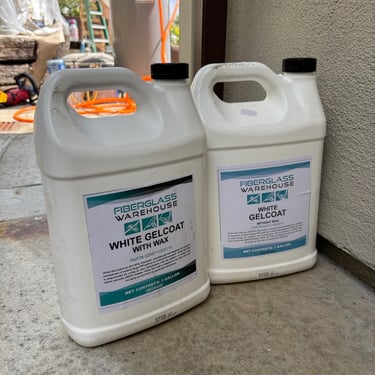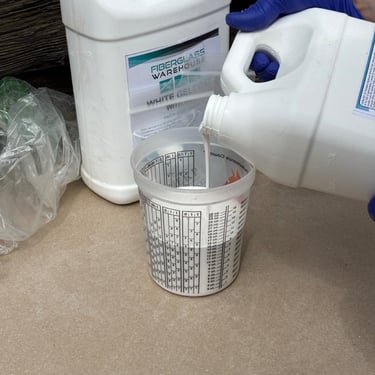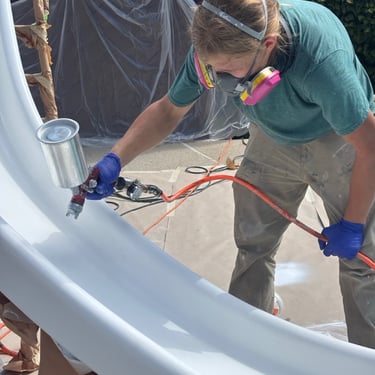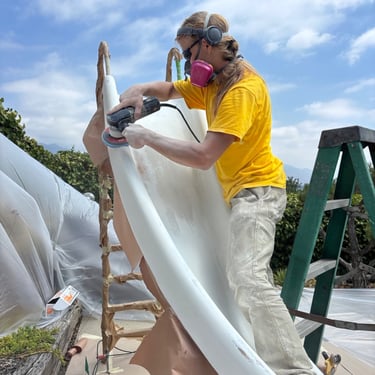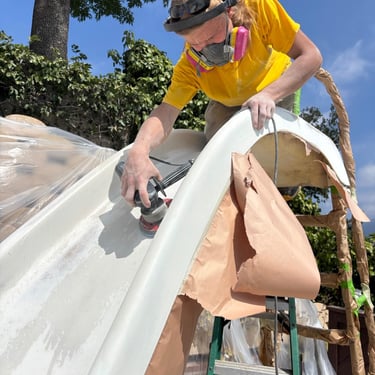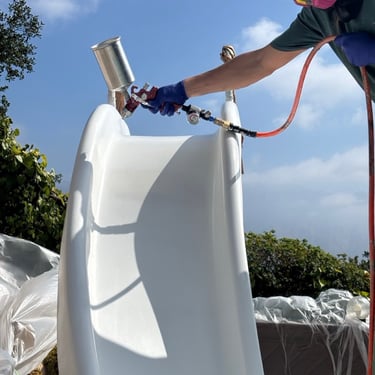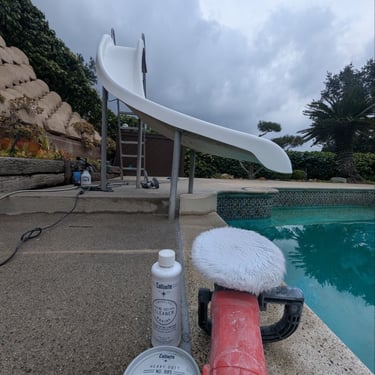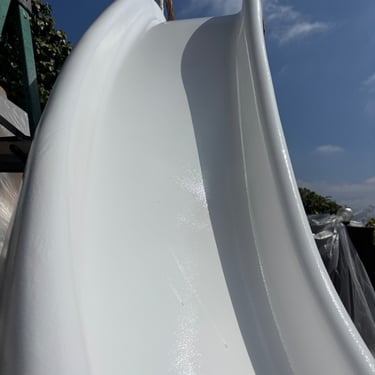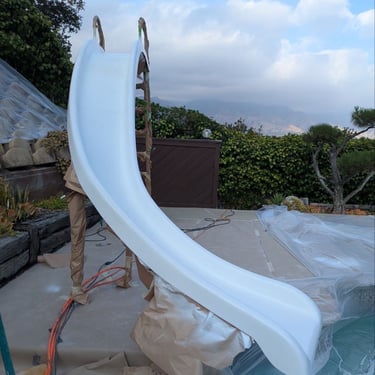Fiberglass Pool Slide Reglazing in Glendale
Full Restoration Using White Gelcoat for a Smooth, Glossy Finish
RESTORATIONOUTDOOR WORKOUR WORKSPAINTING & STAINING
10/15/20253 min read
Over time, even the most durable fiberglass pool slides lose their shine. Constant exposure to sun, chlorine, and water gradually wears down the protective layer. The surface becomes dull, rough, and faded — making the slide not only less attractive but also uncomfortable and unsafe to use.
That’s when fiberglass slide reglazing comes into play — a professional restoration process that brings the slide back to its original smoothness, brightness, and strength using marine-grade gelcoat, the same material used to manufacture boats and swimming pools.
⸻
When Your Fiberglass Slide Needs Reglazing
Here are the most common signs that it’s time to refinish your slide:
• The surface has lost its gloss and feels rough to the touch.
• The white color has turned yellowish or shows discoloration.
• There are small cracks, peeling, or visible fiberglass spots.
• Water leaves marks after use, and sliding becomes slower.
In this project, the pool slide in Glendale, California showed clear signs of aging — the coating had oxidized and lost its original brightness. The homeowner wanted to restore both the look and the performance of the slide to make it safe and enjoyable for the summer season.
⸻
Step 1. Surface Preparation
Every long-lasting restoration starts with proper surface preparation.
The entire slide was thoroughly cleaned, degreased, and sanded to remove the old worn-out gelcoat layer.
We used a random orbital sander with progressively finer sandpaper to achieve a smooth surface without damaging the fiberglass structure.
The surrounding area was carefully masked and covered with plastic and paper to protect from overspray and dust.
⸻
Step 2. Materials Selection: Gelcoat With and Without Wax
For this project, we used professional-grade materials from Fiberglass Warehouse:
• White Gelcoat Without Wax – applied as the base coat for excellent bonding and flexibility between layers.
• White Gelcoat With Wax – used as the top coat to create a hard, non-tacky surface that fully cures to a glossy finish.
This combination ensures a durable, UV-resistant coating with excellent protection against water, chemicals, and sunlight — perfect for poolside applications.
⸻
Step 3. Applying Gelcoat With a Spray Gun
The new gelcoat was applied using a professional spray gun for maximum precision and even coverage.
This technique eliminates brush marks and provides a factory-smooth finish.
The gelcoat was carefully mixed in a graduated container with the proper ratio of MEKP catalyst. Maintaining the correct proportions is crucial — too much hardener can cause cracking, while too little leads to incomplete curing.
Each layer was sprayed evenly, with overlapping passes and controlled drying times between coats.
Once cured, the surface revealed a beautiful glossy white color with a perfectly smooth texture.
⸻
Step 4. Polishing and Final Protection
After the gelcoat had fully cured, the surface was polished and sealed for a mirror-like finish.
We used Collinite No. 920 Fiberglass Cleaner followed by Collinite Fleetwax No. 885, a heavy-duty marine wax that provides long-term UV protection and enhanced slickness.
This final step not only enhances the shine but also protects the surface from oxidation and keeps it easy to clean — water simply slides off without leaving marks.
⸻
Step 5. The Final Result
The result was stunning: the fiberglass slide regained its brand-new appearance — bright, smooth, glossy, and perfectly safe to use.
The project took about two days, including preparation, spraying, and final polishing.
The homeowner was thrilled with the outcome — the slide once again became a beautiful and functional centerpiece of the backyard pool area.
⸻
Why Professional Reglazing Matters
Fiberglass reglazing may look simple, but it requires:
• Accurate mixing of gelcoat and catalyst,
• Professional spraying equipment and an air compressor,
• Skill in achieving even layers without drips,
• Knowledge of sanding, buffing, and curing techniques.
Attempting to do it yourself without the proper tools or experience can lead to uneven coating, bubbles, or early surface failure.
That’s why hiring a professional ensures both the durability and beauty of your restored fiberglass surface.
⸻
Tips for Maintaining Your Restored Slide
To keep your slide looking perfect for years:
1. Clean regularly with mild soap and water — avoid abrasives.
2. Reapply a protective wax once or twice per year.
3. Don’t use harsh chemicals or solvents.
4. Avoid scratches and impacts from hard objects.
5. If minor dull spots appear, they can be polished easily.
⸻
Conclusion
Fiberglass slide reglazing is a cost-effective and long-lasting way to restore faded or damaged pool slides without replacement.
By using premium Fiberglass Warehouse gelcoats and precise spraying techniques, we achieved a durable, water-resistant, and UV-protected finish that will last for many seasons.
If you’re in Glendale or the Greater Los Angeles area and want to bring your pool slide or fiberglass surface back to life — we’re here to help.
⸻
📞 ProHands Handyman
Professional Fiberglass Restoration and Remodeling in Los Angeles & Glendale
Phone: 818-401-7766
Website: www.prohandshandyman.com
